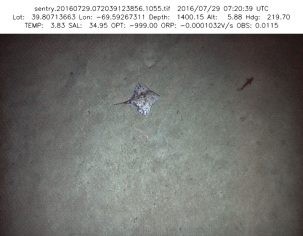Life Aboard a Research Cruise: 24-Hour Workdays, Amazing Discoveries
When scientists say “research cruise,” they aren’t talking about sunny afternoons of shuffleboard and margaritas on deck. Life aboard a research vessel means tight spaces, few amenities, and long workdays.

By Bridgit Boulahanis
“Whenever I find myself growing grim about the mouth; whenever it is a damp, drizzly November in my soul; … then, I account it high time to get to sea as soon as I can.”
― Herman Melville, Moby-Dick
Being drawn to the sea appears to be a part of the human condition, but marine scientists seem especially enticed by the mystery and power of the open ocean. Evidence for this is abundant aboard any research expedition—you have to really love the ocean to want to go to sea as a scientist.
When scientists say “research cruise,” they aren’t talking about sunny afternoons of shuffleboard and margaritas on deck. Life aboard a research vessel means tight spaces, few amenities, and workdays that can easily last 24 hours or more.

Research expeditions are expensive, and scientific funding is limited, so it is crucial that scientists make the most of the little time that we get at sea. Research vessels take advantage of the entire day, with a portion of the science party working during daylight hours and the rest working through the night. Many researchers work not just their own shift, but a portion of the next one, as well. Sleep is limited, meals are abbreviated, and the work often requires hours of physical labor. Sometimes life aboard the vessel feels like an exhausting slog.
There are also aspects of being at sea that are enthralling, wonderful, fascinating. When you’re aboard a research vessel, the lines between senior faculty and graduate students become thin, and collaboration is immediate and constant. The excitement of data streaming in real time and looking at preliminary results can be intoxicating. There are moments of panic when it looks like things won’t go as planned, and then there are also moments of absolute joy when everything falls into place.
Friday morning fell into the absolute joy category—during the previous night we had collected shipboard multibeam data, over 600 gigabytes of data from the autonomous underwater vehicle (AUV) Sentry, and successfully deployed a multicore that collected several feet of sediment. We found exactly what we expected and hoped for—a spot on the seafloor where methane bubbles up from below. Methane, a greenhouse gas that many people associate with cows, naturally seeps out of the seafloor in many places.

Even though current scientific understanding suggests that this particular source of methane doesn’t significantly contribute to climate change, it is important for scientists to understand and quantify all of the various sources of methane, and this is one difficult type to find. These vent sites are also fascinating because they are so often home to a wide variety of marine life: microbial communities, deep sea corals and crustaceans can be found around them. Sentry‘s photos from our first dive show that these creatures are present (and some even abundant) in the region where Alvin, the human-occupied submersible that we’re also working with, will descend with two scientists on Saturday.
Usually by the time scientists leave a ship after a research cruise, we are drained to the point of collapse, but exhilarated with the results to come. That exhilarating thrill of discovery may be why, for many of us, going to sea feels like coming home.
Bridgit Boulahanis is a marine geophysics graduate student at Columbia University’s Lamont-Doherty Earth Observatory. Her research utilizes multichannel seismic reflection and refraction studies as well as multibeam mapping data to explore Mid-Ocean Ridge dynamics, submarine volcanic eruptions, and how oceanic crustal accretion changes through time. Read more about the training cruise in her first post.
Save
Save
Save
